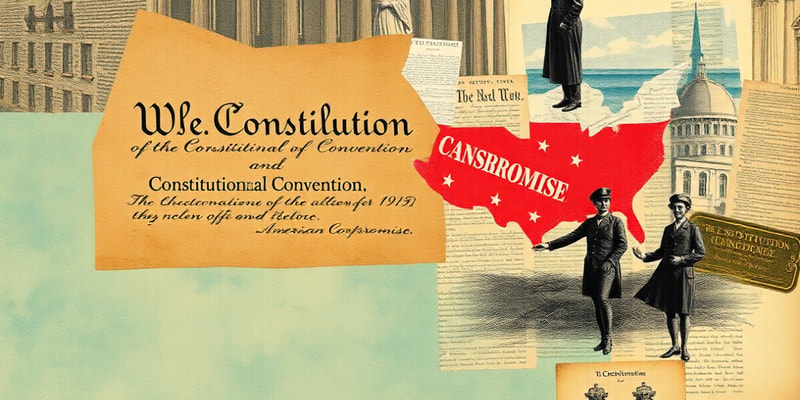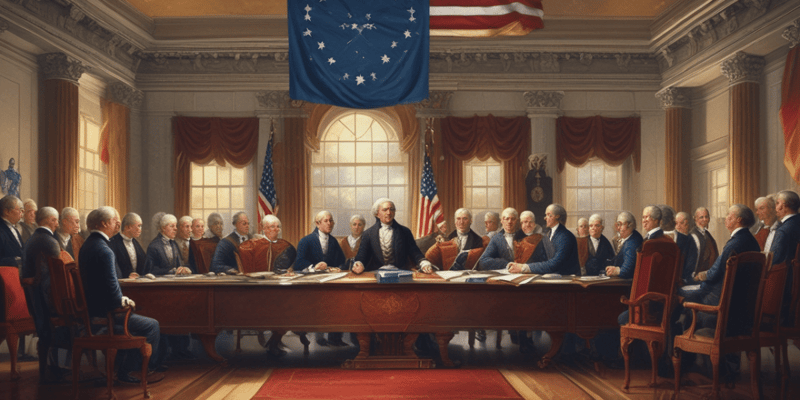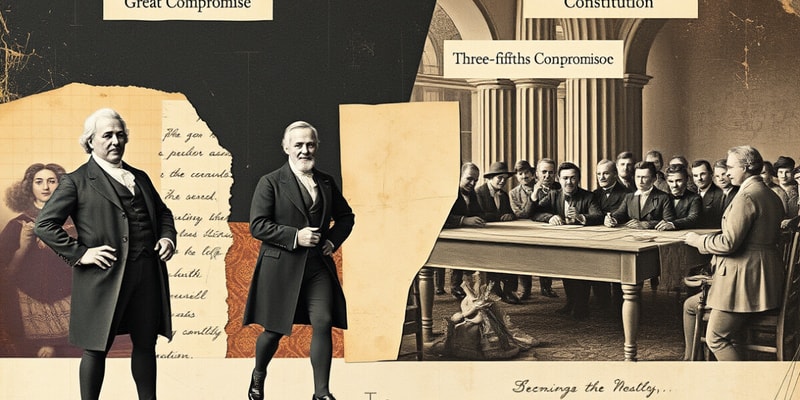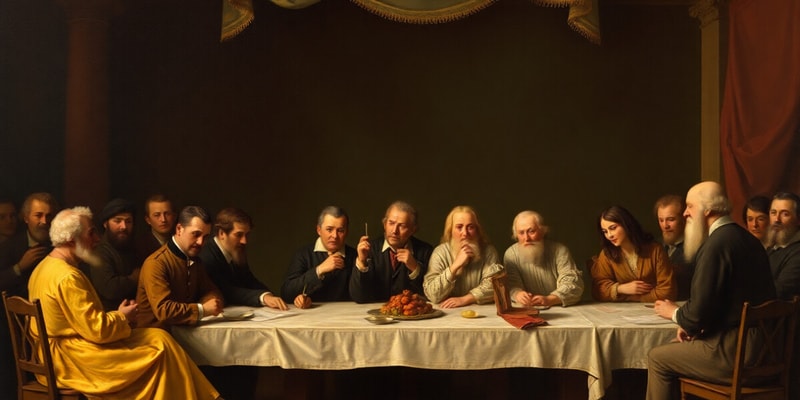Podcast
Questions and Answers
What restricts the ease with which legislation can be passed in Congress?
What restricts the ease with which legislation can be passed in Congress?
What was one effect of the Articles of Confederation that influenced the Constitutional Convention?
What was one effect of the Articles of Confederation that influenced the Constitutional Convention?
What adjustment occurs every ten years in relation to congressional membership?
What adjustment occurs every ten years in relation to congressional membership?
What was the guaranteed number of representatives each state could have in the House?
What was the guaranteed number of representatives each state could have in the House?
Signup and view all the answers
Which concept played a significant role in the structure of the U.S. bicameral legislature?
Which concept played a significant role in the structure of the U.S. bicameral legislature?
Signup and view all the answers
What is one reason the framers designed a difficult legislative process?
What is one reason the framers designed a difficult legislative process?
Signup and view all the answers
Which type of representation does Washington, DC have in Congress?
Which type of representation does Washington, DC have in Congress?
Signup and view all the answers
What was a significant proposal made by Virginia's delegates during the Constitutional Convention?
What was a significant proposal made by Virginia's delegates during the Constitutional Convention?
Signup and view all the answers
What was one of the primary reasons that larger states opposed the existing system under the Articles of Confederation?
What was one of the primary reasons that larger states opposed the existing system under the Articles of Confederation?
Signup and view all the answers
What was the ultimate outcome of the discussions at the Constitutional Convention?
What was the ultimate outcome of the discussions at the Constitutional Convention?
Signup and view all the answers
Which compromises were essential in the establishment of the bicameral Congress?
Which compromises were essential in the establishment of the bicameral Congress?
Signup and view all the answers
Which clause of the Constitution allows Congress to take actions not explicitly listed as powers?
Which clause of the Constitution allows Congress to take actions not explicitly listed as powers?
Signup and view all the answers
What is a key reason most of Congress's daily actions are not included in the enumerated powers?
What is a key reason most of Congress's daily actions are not included in the enumerated powers?
Signup and view all the answers
What ensures that the removal of a president is a rare occurrence?
What ensures that the removal of a president is a rare occurrence?
Signup and view all the answers
What distinguishes inherent powers from enumerated and implied powers?
What distinguishes inherent powers from enumerated and implied powers?
Signup and view all the answers
What responsibility is not uniquely assigned to the House of Representatives?
What responsibility is not uniquely assigned to the House of Representatives?
Signup and view all the answers
What is the primary role of the Speaker of the House?
What is the primary role of the Speaker of the House?
Signup and view all the answers
How does the committee system in Congress primarily benefit the legislative process?
How does the committee system in Congress primarily benefit the legislative process?
Signup and view all the answers
What role do party conferences play in the House of Representatives?
What role do party conferences play in the House of Representatives?
Signup and view all the answers
Which position is specifically mentioned in the Constitution as a key leadership role in the House?
Which position is specifically mentioned in the Constitution as a key leadership role in the House?
Signup and view all the answers
What determines which party conference is considered the majority in Congress?
What determines which party conference is considered the majority in Congress?
Signup and view all the answers
What happens to the Speaker of the House when their party loses a majority?
What happens to the Speaker of the House when their party loses a majority?
Signup and view all the answers
In what way is the Speaker of the House crucial to the functioning of Congress?
In what way is the Speaker of the House crucial to the functioning of Congress?
Signup and view all the answers
What distinguishes the Speaker's position from other congressional leaders?
What distinguishes the Speaker's position from other congressional leaders?
Signup and view all the answers
What may occur if the Speaker of the House feels their leadership position is threatened?
What may occur if the Speaker of the House feels their leadership position is threatened?
Signup and view all the answers
Which practice weakens the specialization monopolies of committees in the House and Senate?
Which practice weakens the specialization monopolies of committees in the House and Senate?
Signup and view all the answers
What is the primary role of standing committees in Congress?
What is the primary role of standing committees in Congress?
Signup and view all the answers
What is a significant power held by committee chairs in the House of Representatives?
What is a significant power held by committee chairs in the House of Representatives?
Signup and view all the answers
What ultimately happens to most legislation proposed in Congress?
What ultimately happens to most legislation proposed in Congress?
Signup and view all the answers
Which group typically provides expert opinions during the bill hearing process?
Which group typically provides expert opinions during the bill hearing process?
Signup and view all the answers
What is a characteristic of hearings held by committees in Congress?
What is a characteristic of hearings held by committees in Congress?
Signup and view all the answers
What happens to a bill if a committee decides not to advance it after the markup stage?
What happens to a bill if a committee decides not to advance it after the markup stage?
Signup and view all the answers
What is required for the Senate to invoke cloture and end a filibuster?
What is required for the Senate to invoke cloture and end a filibuster?
Signup and view all the answers
Which tactic was historically used by senators to prevent the Senate from acting on a bill?
Which tactic was historically used by senators to prevent the Senate from acting on a bill?
Signup and view all the answers
What is one method Congress can use to resolve differences in bills passed by the House and Senate?
What is one method Congress can use to resolve differences in bills passed by the House and Senate?
Signup and view all the answers
Which outcomes are possible if the president vetoes a bill?
Which outcomes are possible if the president vetoes a bill?
Signup and view all the answers
How has the process for passing legislation changed in recent decades?
How has the process for passing legislation changed in recent decades?
Signup and view all the answers
Study Notes
The Origins of the U.S. Constitution and the Convention
- The Articles of Confederation failed to keep the young republic together.
- Delegates from all states (except Rhode Island) met in Philadelphia in 1787 to revise the Articles.
- The Constitutional Convention of 1787 ultimately replaced the Articles with the U.S. Constitution.
The Great Compromise and Bicameralism
- Virginia proposed a bicameral Congress with representation based on population, favoring larger states.
- New Jersey countered with a single-chamber Congress with equal representation, favoring smaller states.
- The Connecticut Compromise, or Great Compromise, established a two-chamber Congress:
- The Senate: two senators per state, satisfying smaller states.
- The House of Representatives: representation based on population, fulfilling the needs of larger states.
Powers and Limitations of Congress
- Article I of the U.S. Constitution outlines the powers and limitations of Congress.
- Congress has the power to:
- Levy taxes
- Borrow money
- Regulate commerce
- Congress has the power to set minimum age requirements for members.
Bicameralism: A Look at History and Function
- The concept of a bicameral legislature is deeply rooted in European history.
- The framers intentionally structured the U.S. Senate differently from the House of Representatives to foster diverse representation.
- The bicameral system requires both houses to pass identical bills, ensuring deliberation and consensus.
- This system:
- Prevents impulsive legislation.
- Promotes conservatism in government.
- Makes it difficult for one group to dominate and enact unfair laws.
Apportionment of Seats in the House and Senate
- The Senate has 100 seats, with two senators from each state.
- Senators were initially appointed by state legislatures but are now elected by popular vote.
- The House of Representatives has 435 seats, distributed based on each state's population.
- Each state is guaranteed at least one seat in the House.
- The equal proportions method is used to allocate seats based on U.S. Census Bureau population data every ten years.
Redistricting and Challenges to Representation
- Redistricting occurs every ten years after the Census to ensure each district has a similar number of voters.
- The number of representatives in the House is capped at 435.
- Challenges to fair representation:
- The size of a representative's constituency averages over 700,000.
- Residents of Washington, D.C., lack voting representation in the House.
The Three-Fifths Compromise and Gerrymandering
- The Three-Fifths Compromise counted enslaved people as three-fifths of a person for congressional representation.
- Gerrymandering involves manipulating legislative district boundaries to favor a particular candidate or party.
- Gerrymandering can dilute the voting power of minority groups and create "safe seats" for a particular party.
- While questionable ethically, gerrymandering is legal.
The Voting Rights Act of 1965 and its Impact
- Following the abolition of slavery and the end of Reconstruction, attempts were made to prevent African Americans from voting.
- The Voting Rights Act of 1965 removed many hurdles to voter registration and voting for African Americans.
- The act led to the creation of majority-minority districts to enhance African American representation in Congress.
- While these districts achieved their goals, they have also been criticized as a form of gerrymandering.
Congressional Power: Checks and Balances
- Congress has significant power to check the executive branch.
- Congress has the sole power to introduce legislation, restricting the president's ability to independently develop laws they are empowered to enforce.
- The Senate's power to approve the president's nominees for cabinet positions and judicial appointments forces the president to consider Congress's perspective when selecting key government officials.
- The House of Representatives can impeach the president or other federal officials for wrongdoing, initiating the process of removal from office. The Senate conducts the trial and ultimately decides whether to remove the official. This process ensures the president's power is accountable and safeguards against potential abuse of power.
Congressional Power: Beyond the Enumerated
- The Constitution grants Congress broad powers beyond those explicitly listed.
- The Necessary and Proper Clause allows Congress to pass laws that are "necessary and proper" for carrying out its enumerated powers. This has been a significant source of congressional power, enabling the creation of laws regarding banking, minimum wage, and interstate highway construction.
- Inherent powers are those that Congress assumes are essential for the government to function, even though they are not explicitly stated in the Constitution. These include controlling borders, expanding territory, and defending against internal threats.
The Significance of Congressional Power
- The power of Congress is rooted in its constitutional role as a legislative branch.
- Congressional powers serve as checks and balances against other branches, ensuring a separation of powers and a system of accountability.
- Congress's ability to make laws, approve nominations, impeach officials, and exercise inherent powers underscores its crucial role in governing the United States.
Congress Leadership
- Congress has two major parties - the Democrats and the Republicans
- Each party has a conference in each chamber
- The conference elects party leaders. These leaders manage the party members in each chamber
- Each Conference has a majority conference and minority conference
- The majority Conference is the party with more members
- The minority Conference is the party with fewer members
- The Speaker of the House is elected by the entire House of Representatives
- The Speaker of the House is the presiding officer of the House of Representatives
- The Speaker is the administrative head of the House
- The Speaker is the elected representative of a single congressional district
- The Speaker is the partisan leader of the majority party in the House
- The Speaker acts as a leader for the majority party in the House
- The Speaker oversees the House of Representatives
- The Speaker has the power to assign bills to committees
- The Speaker has the power to decide when a bill will be presented to the floor for a vote
- The Speaker has the power to appoint members and chairs to committees
- The Speaker has the authority to create select committees
- The Speaker can select a member to be speaker pro tempore
- The Speaker presides over joint sessions between the House and Senate
- Each conference elects two leaders: the majority and minority leaders
- Majority leaders have more power than minority leaders because they are the leading members of the governing party
- The majority leader is in the best position to become Speaker when the current Speaker leaves
- Whips are responsible for ensuring party discipline
- Whips ensure members of the party vote as a bloc
- Whips are responsible for encouraging members to toe the party line
- The Senate also has majority and minority leaders and whips
- The Senate does not have a Speaker of the House
- The duties of the Speaker of the House are performed by the majority leader in the Senate
- The President of the Senate is the Vice President of the United States
- The President of the Senate can only vote in case of a tie
- The Senate has a President Pro Tempore who acts as the presiding officer
- The President Pro Tempore is usually the most senior Senator of the majority party
- The President Pro Tempore is largely a ceremonial role
The Committee System
- The committee system is important to Congress for organizing the work of the chamber
- Each chamber has a specialized committee system that divides the workload
- Bills are created within committees
- Committees have subcommittees, select committees and joint committees
- Most of the work that sets the Congressional agenda takes place within committees
- Standing Committees form the core of the committee system
- There are 20 standing committees in the House of Representatives and 16 in the Senate.
Congressional Committees
- Committees in the House and Senate have significant power over the legislative process.
- Committees hold hearings to gather information and consider expert opinions.
- While committees are chaired by members of the majority party, all members of the house or senate can participate.
- Most bills die in committee, but those that move forward are sent to the chamber with a committee report.
- The committee report includes the majority opinion on the bill, a minority view, and cost and impact estimates.
- The House and Senate each have four types of committees: standing, joint, conference, and ad hoc.
- Standing committees, permanent committees, are the first to consider most proposed bills.
- Joint committees, with members from both houses, review specific topics, but lack bill-referral authority.
- Conference committees, used for reconciling bills differing between the House and Senate, are appointed as needed.
- Ad hoc committees are temporary, focusing on specific issues like aging or ethics.
- Committee hearings can become highly political, as seen in the House Select Committee on Benghazi.
- Members of Congress often seek committee positions that align with their experience and interests.
- Committee chairs wield significant power over the committee, controlling budgets and meeting procedures.
- House committee chairs have term limits, while Senate chairs have longer terms but may hold multiple positions.
- Senate committees have a wider scope for policy review given the smaller size of the chamber.
- Historically, House members respect committee decisions, while senators view them as recommendations, encouraging debate.
Traditional Lawmaking
- The traditional legislative process involves drafting, introduction, referral to committee, hearings, markup, and voting.
- While anyone can draft legislation, only members of Congress can introduce bills.
- Revenue bills must originate in the House, as stipulated in the Constitution.
- Once introduced, bills are referred to a committee by the majority leadership, following the parliamentarian's advice.
- Committees may hold hearings to gather expert opinions on a bill.
- In markup, amendments are discussed and voted upon.
- A bill is tabled if the committee decides not to advance it, killing the bill unless brought back for a vote.
- Bills advancing from committee are sent to the full chamber (House or Senate).
- In the House, bills are subject to rules established by the Committee on Rules, including debate limits.
- Bills advancing in the House are sent to the Senate.
- Senate committees may also review bills.
- The Senate is more flexible with debate rules, allowing for filibusters.
- A filibuster is a tactic where a senator speaks for extended periods to prevent the Senate from taking action.
- Rule 22 allows Senate to hold a cloture vote to end debate, requiring two-thirds majority.
- Cloture threshold was lowered to three-fifths in 1975, except for judicial nominations requiring a simple majority.
- The budget reconciliation process allows some bills to be passed with a simple majority, avoiding filibusters.
- If a bill passes both chambers, it goes to the president for approval.
- If the president vetoes a bill, Congress can override the veto with a two-thirds majority in both chambers.
Modern Lawmaking
- The modern legislative process has adapted, incorporating new methods and shifts in power dynamics.
- Budget reforms of the 1970s introduced a new mechanism for comprehensive policy changes.
- Using budget resolutions to pass policy changes, known as omnibus bills, gained popularity in the 1980s.
- Greater power and influence of party leadership over congressional bills has increased in recent decades.
- Heightened partisanship creates a need for party leadership to guide bills, influencing outcomes.
- House leadership uses special rules to manage bills and restrict debate and amendments.
- Multiple referrals of bills to numerous committees have reduced the specialized power of committees.
- Senate leadership can employ the modern filibuster, requiring a supermajority (60 votes) to proceed with a bill.
- Modern filibuster is a perversion of cloture rules, giving minority power to obstruct legislation easily.
Studying That Suits You
Use AI to generate personalized quizzes and flashcards to suit your learning preferences.
Description
Pages: 374-376, 377, 378, 380, 396-397, 398, 399, 400, 401, 402, 403, 404.





